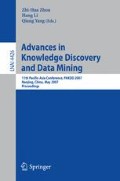Abstract
Principal curves were proposed as the nonlinear generalization of PCA. However, for the tasks of feature extraction for signal representation at which PCA is adept, existing definitions of principal curves have some weakness in their theoretical bases thus fail to get reasonable results in many situations. In this paper, a new definition of principal curves - Principal Curve with Feature Continuity (PCFC) is proposed. PCFC focuses on both reconstruction error minimization and feature continuity. It builds a continuous mapping from samples to the extracted features so the features preserve the inner structures of the sample set, which benefits the researchers to learn the properties of the sample set. The existence and the differential properties of PCFC are studied and the results are presented in this paper.
Access this chapter
Tax calculation will be finalised at checkout
Purchases are for personal use only
Preview
Unable to display preview. Download preview PDF.
References
Hastie, T., Stuetzle, W.: Principal curves. Journal of the American Statistical Association 84(406), 502–516 (1989)
Tibshirani, R.: Principal curves revisited. Statistics and Computation, 183–190 (1992)
Kégl, B., et al.: Learning and design of principal curves. IEEE Transaction on Pattern Analysis and Machine Intelligence 22(3), 281–297 (2000)
Sandilya, S., Kulkarni, S.R.: Principal curves with bounded turn. IEEE Trans. on Information Theory 48(10), 2789–2793 (2002)
Delicado, P.: Another look at principal curves and surfaces. Journal of Multivariate Analysis 77(2), 84–116 (2001)
Kégl, B., Krzyzak, A.: Piecewise linear skeletonization using principal curves. IEEE Transaction on Pattern Analysis and Machine Intelligence 24(1), 59–74 (2002)
Byers, S., Raftery, A.E.: Nearest neighbor clutter removal for estimating features in spatial point processes. Technical report, Department of Statistics University of Washington (1996)
Alexandrov, A.D., Reshetnyak, Y.G.: General Theory of Irregular Curves. Kluwer Academic Publishers, Dordrecht (1989)
Author information
Authors and Affiliations
Editor information
Rights and permissions
Copyright information
© 2007 Springer Berlin Heidelberg
About this paper
Cite this paper
Sun, Mm., Yang, Jy. (2007). Principal Curves with Feature Continuity. In: Zhou, ZH., Li, H., Yang, Q. (eds) Advances in Knowledge Discovery and Data Mining. PAKDD 2007. Lecture Notes in Computer Science(), vol 4426. Springer, Berlin, Heidelberg. https://doi.org/10.1007/978-3-540-71701-0_86
Download citation
DOI: https://doi.org/10.1007/978-3-540-71701-0_86
Publisher Name: Springer, Berlin, Heidelberg
Print ISBN: 978-3-540-71700-3
Online ISBN: 978-3-540-71701-0
eBook Packages: Computer ScienceComputer Science (R0)

